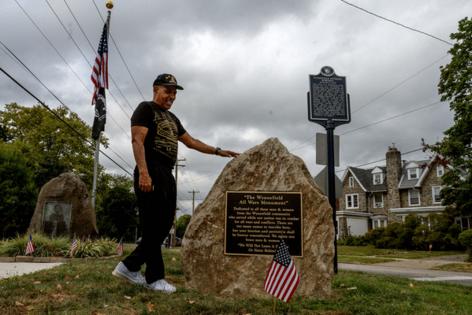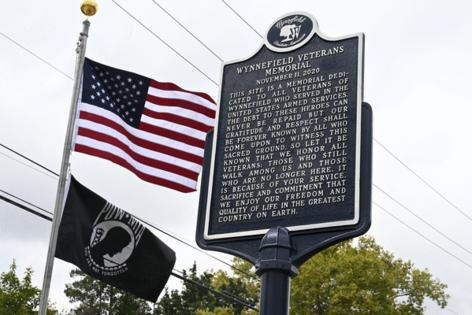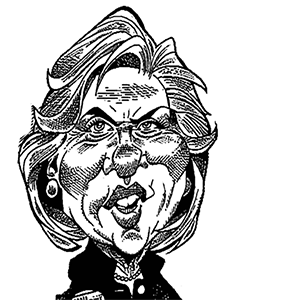On National POW/MIA Recognition Day, some veterans say too few POW/MIA flags are flying
Published in News & Features
PHILADELPHIA — When Michael Reid moved to Wynnefield about 25 years ago, he came upon a small, unkempt plot of weeds and trash at 54th Street and Wynnefield Avenue during a stroll around his new neighborhood.
Curious, he pushed aside the overgrown grass to get a closer look and found a long hidden memorial plaque attached to a boulder. It read "Residents of Wynnefield in the service of the United States in the Great War," a tribute to the community's WWI veterans who died in battle.
"There's 21 names on the plaque," said Reid, a Desert Storm-era Army veteran. He had no other information about the history behind those names or who established the memorial.
It motivated Reid to clean up the small plot and create the Wynnefield Veterans Memorial. Each year, with the help of a few volunteers, he adds more items to the neatly maintained triangular plot, including a POW/MIA flag.
And he has one hope: that people will stop, look, and remember.
National POW/MIA Recognition Day
Every third Friday in September, the POW/MIA flag takes center stage as the country commemorates National POW/MIA Recognition Day.
Memorial Day is a tribute to all who lost their lives in service to the United States. Veterans Day celebrates all military veterans. And POW/MIA Recognition Day is a somber occasion that asks us to remember those who have not returned home. According to the Defense POW/MIA Accounting Agency (DPAA), almost 82,000 Americans, dating to WWII, are still unaccounted for.
"Think of it like this: It's like you [get up] to work, you drink your coffee, kiss your spouse goodbye, and never come back," said Reid, who organizes a large Veterans Day event annually at the Wynnefield Veterans Memorial.
The real heroes
The first National POW/MIA Recognition Day took place in 1979, but the flag wasn't prominently displayed until 1982. "It is a fitting mark of recognition of the uncommon sacrifices of all former American prisoners of war, those still missing, and their families, that a P.O.W.-M.I.A. flag fly over the White House and the Pentagon," President Ronald Reagan proclaimed that year.
In 1971, a New Jersey graphic designer and veteran, Newton F. Heisley, received an assignment from his advertising agency to sketch a flag for their client Annin & Company, at the time the world's largest flag manufacturer. He thought they would make a small batch of flags for the National League of Families of American Prisoners and Missing in Southeast Asia to use for promotions.
He drew a black-and-white flag with a silhouette of a man with his head bowed, a guard tower, and a strand of barbed wire with the words "You Are Not Forgotten" at the bottom.
In 1990, President George H.W. Bush designated the POW/MIA flag as our country's official symbol of concern for POWs and MIAs in Southeast Asia.
Heisley, a former WWII pilot, once said in an interview, "No one realized it was going to get national attention."
Displaying a symbol of concern
Pennsylvania has over 700,000 veterans, the fourth-largest veteran population in the United States. One of those veterans is Alan Micklin, who has made it his mission to make sure the POW/MIA flag is displayed on every flagpole that flies an American flag.
Micklin is a Vietnam-era veteran whose primary advocacy tool is dogged persistence.
Wherever he goes he strikes up a conversation starting with, "Do you know what the POW/MIA flag is?" He tries to come away with a commitment to display the flag. It's happened nationally with Lowe's, which now flies the flag outside its 1,700 stores, and locally with DeChristopher Bros. Monuments & Memorials — a century-old city business — and at Brown's Super Stores.
"This flag symbolizes our commitment to remembering those who have served and the brave individuals who have not returned home," Sandy Brown, executive vice president of Brown's Super Stores, said in an email. "By displaying it in our stores, we hope to show our gratitude and keep the spirit of their sacrifice present in our community."
"And just this week, Bucks County commissioners approved that every flagpole that is controlled by the county will fly a POW/MIA flag," Micklin said.
For Micklin there is still much to do, as many Americans have no idea what the POW/MIA flag is and have forgotten the 82,000 soldiers whose fate is still a mystery. That's why he is now pushing for every school in the country to fly the POW/MIA flag and for every student to learn the meaning of the symbol.
"Every flag that goes up is an accomplishment, but it is really about recognizing the people who never came home," Micklin said.
©2024 The Philadelphia Inquirer, LLC. Visit at inquirer.com. Distributed by Tribune Content Agency, LLC.












Comments